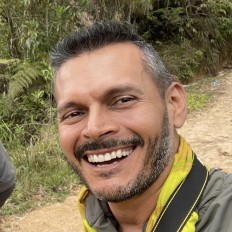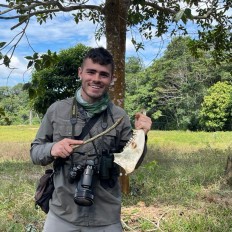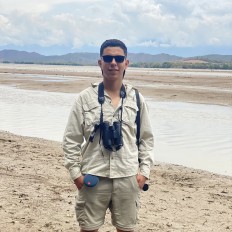Top species
- Green Hermit (Phaethornis guy)
- Ecuadorian Piedtail (Phlogophilus hemileucurus)
- White-booted Racket-tail (Ocreatus underwoodii)
- Green-backed Hillstar (Urochroa leucura)
- Rufous-vented Whitetip (Urosticte ruficrissa)
- Violet-fronted Brilliant (Heliodoxa leadbeateri)
- Golden-tailed Sapphire (Chrysuronia oenone)
- Black-and-chestnut Eagle (Spizaetus isidori)
- Coppery-chested Jacamar (Galbula pastazae)
- Rufous-rumped Antwren (Euchrepomis callinota)
- Foothill Stipplethroat (Epinecrophylla spodionota)
- Chestnut-crowned Gnateater (Conopophaga castaneiceps)
- Black-billed Treehunter (Thripadectes melanorhynchus)
- Fiery-throated Fruiteater (Pipreola chlorolepidota)
- Black-and-white Becard (Pachyramphus albogriseus)
- Cliff Flycatcher (Hirundinea ferruginea)
- Gray-mantled Wren (Odontorchilus branickii)
- Rufous-breasted Wren (Pheugopedius rutilus)
- Magpie Tanager (Cissopis leverianus)
- Orange-eared Tanager (Chlorochrysa calliparaea)
- Speckled Tanager (Ixothraupis guttata)
- Blue-browed Tanager (Tangara cyanotis)
- Turquoise Tanager (Tangara mexicana)
- Paradise Tanager (Tangara chilensis)
- Flame-faced Tanager (Tangara parzudakii)
- Deep-blue Flowerpiercer (Diglossa glauca)
List up to ca. 25 species that:
• have a limited distribution range and/or are rare on a global level
• are most sought-after by birdwatchers at this site
• and are relatively easy to see at this site (year-round or seasonally)
| Green Hermit (Phaethornis guy) | |
| Ecuadorian Piedtail (Phlogophilus hemileucurus) | |
| White-booted Racket-tail (Ocreatus underwoodii) | |
| Green-backed Hillstar (Urochroa leucura) | |
| Rufous-vented Whitetip (Urosticte ruficrissa) | |
| Violet-fronted Brilliant (Heliodoxa leadbeateri) | |
| Golden-tailed Sapphire (Chrysuronia oenone) | |
| Black-and-chestnut Eagle (Spizaetus isidori) | |
| Coppery-chested Jacamar (Galbula pastazae) | |
| Rufous-rumped Antwren (Euchrepomis callinota) | |
| Foothill Stipplethroat (Epinecrophylla spodionota) | |
| Chestnut-crowned Gnateater (Conopophaga castaneiceps) | |
| Black-billed Treehunter (Thripadectes melanorhynchus) | |
| Fiery-throated Fruiteater (Pipreola chlorolepidota) | |
| Black-and-white Becard (Pachyramphus albogriseus) | |
| Cliff Flycatcher (Hirundinea ferruginea) | |
| Gray-mantled Wren (Odontorchilus branickii) | |
| Rufous-breasted Wren (Pheugopedius rutilus) | |
| Magpie Tanager (Cissopis leverianus) | |
| Orange-eared Tanager (Chlorochrysa calliparaea) | |
| Speckled Tanager (Ixothraupis guttata) | |
| Blue-browed Tanager (Tangara cyanotis) | |
| Turquoise Tanager (Tangara mexicana) | |
| Paradise Tanager (Tangara chilensis) | |
| Flame-faced Tanager (Tangara parzudakii) | |
| Deep-blue Flowerpiercer (Diglossa glauca) |
Speckled Tanager (Ixothraupis guttata) was added by Jorge Muñoz García (2023-07-28 17:59:20)
Green Hermit (Phaethornis guy) was added by Jorge Muñoz García (2023-07-28 17:58:26)
Foothill Stipplethroat (Epinecrophylla spodionota) was added by Jorge Muñoz García (2023-07-28 17:58:05)
Flame-faced Tanager (Tangara parzudakii) was added by Jorge Muñoz García (2023-07-28 17:57:41)
Rufous-vented Whitetip (Urosticte ruficrissa) was added by Jorge Muñoz García (2023-07-28 17:56:56)
Violet-fronted Brilliant (Heliodoxa leadbeateri) was added by Jorge Muñoz García (2023-07-28 17:49:05)
Ecuadorian Piedtail (Phlogophilus hemileucurus) was added by Jorge Muñoz García (2023-07-28 17:48:43)
Green-backed Hillstar (Urochroa leucura) was added by Jorge Muñoz García (2023-07-28 17:48:04)
Chestnut-crowned Gnateater (Conopophaga castaneiceps) was added by Jorge Muñoz García (2022-07-01 04:54:24)
Fiery-throated Fruiteater (Pipreola chlorolepidota) was added by Jorge Muñoz García (2021-09-25 02:11:34)
Rufous-rumped Antwren (Euchrepomis callinota) was added by Jorge Muñoz García (2021-09-25 02:08:46)
Cliff Flycatcher (Hirundinea ferruginea) was added by Jorge Muñoz García (2021-09-25 02:08:37)
Gray-mantled Wren (Odontorchilus branickii) was added by Jorge Muñoz García (2021-09-25 02:08:07)
Turquoise Tanager (Tangara mexicana) was added by Jorge Muñoz García (2021-09-25 02:07:55)
Golden-tailed Sapphire (Chrysuronia oenone) was added by Jorge Muñoz García (2021-09-25 02:07:34)
Magpie Tanager (Cissopis leverianus) was added by Jorge Muñoz García (2021-09-25 02:07:06)
White-booted Racket-tail (Ocreatus underwoodii) was added by Jorge Muñoz García (2021-09-25 02:06:52)
Black-and-white Becard (Pachyramphus albogriseus) was added by Jorge Muñoz García (2021-09-25 02:06:42)
Black-billed Treehunter (Thripadectes melanorhynchus) was added by Jorge Muñoz García (2021-09-25 02:06:20)
Blue-browed Tanager (Tangara cyanotis) was added by Jorge Muñoz García (2021-09-25 02:06:06)
Rufous-breasted Wren (Pheugopedius rutilus) was added by Jorge Muñoz García (2021-09-25 02:05:51)
Paradise Tanager (Tangara chilensis) was added by Jorge Muñoz García (2021-09-25 02:05:30)
Orange-eared Tanager (Chlorochrysa calliparaea) was added by Jorge Muñoz García (2021-09-25 02:05:18)
Black-and-chestnut Eagle (Spizaetus isidori) was added by Jorge Muñoz García (2021-09-25 02:04:55)
Deep-blue Flowerpiercer (Diglossa glauca) was added by Jorge Muñoz García (2021-09-25 02:04:39)
Coppery-chested Jacamar (Galbula pastazae) was added by Jorge Muñoz García (2021-09-25 02:04:28)




